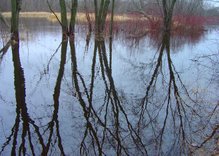local life
 It occurs to me that I haven't been much abiding by the avowed subject matter noted in the header to this blog: local life is not much present. Here is a beginning attempt to attend to that deficiency.
It occurs to me that I haven't been much abiding by the avowed subject matter noted in the header to this blog: local life is not much present. Here is a beginning attempt to attend to that deficiency.
Last night thunderstorms brought four-tenths of an inch of rain to the very dry earth. I was noticing earlier yesterday how the grass had already begun to wilt. But tonight the frogs started to sing again after being very quiet during most of a dry spell in the first half of May. There was a strong south wind all day yesterday that led to near calm and mosquito-friendly air by 7:00pm. The rain came just before midnight, while Sally and I talked with friends on main street, Wadena. The town was quiet and mostly dark, and frequent lightning flashed as we drove north toward home.
The weather report suggests that we may have a wetter week upcoming. Let's hope so. It makes me feel better, knowing that some patterns persist in our altered world. I connect the good weather news with good news about our grandson, Tate. We just got word from our son, Colin, that Tate, now nearly a month old, is doing better after a very scary time with liver enzyme issues. All the events, personal and public in our lives, remind me to remain hopeful rather than optimistic about just about everything. I'm still struck by how farmers around here plant when the earth seems so dry that nothing would germinate. And sometimes their hope is rewarded, and after a dry time the rain comes.
The bloodroot pictured above has just finished blooming. The cowslip is in bloom in the ditches and swamps, and prairie smoke is blooming now too, as well as lilacs and chokecherry. Wild plum is already past. This is one of the best times of year here.






